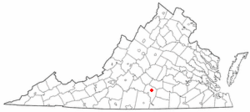Charlotte Court House, Virginia facts for kids
Quick facts for kids
Charlotte Court House, Virginia
|
||
|---|---|---|

Central Charlotte Court House
|
||
|
||

Location of Charlotte Court House, Virginia
|
||
| Country | United States | |
| State | Virginia | |
| County | Charlotte | |
| Government | ||
| • Type | Mayor/Council | |
| Area | ||
| • Total | 3.96 sq mi (10.3 km2) | |
| • Land | 3.96 sq mi (10.3 km2) | |
| • Water | 0.00 sq mi (0 km2) | |
| Elevation | 620 ft (190 m) | |
| Population
(2020)
|
||
| • Total | 756 | |
| • Density | 190.9/sq mi (73.7/km2) | |
| Time zone | UTC−5 (Eastern (EST)) | |
| • Summer (DST) | UTC−4 (EDT) | |
| ZIP code |
23923
|
|
| Area code | 434 | |
| FIPS code | 51-14952 | |
| GNIS feature ID | 1498462 | |
Charlotte Court House is a small town in Virginia, United States. It is the main town, or county seat, of Charlotte County. In 2020, about 756 people lived there.
Contents
Where is Charlotte Court House?
The town is located right in the middle of Charlotte County. You can find it by following Virginia State Route 40, which goes through the town center. This road leads west about 19 miles to a town called Brookneal. If you go east, it's about 9 miles to Keysville.
Another road, Virginia State Route 47, crosses Route 40 in the center of town. If you head north on Route 47, it's about 17 miles to Pamplin. Going south on Route 47 takes you about 13 miles to U.S. Route 15. The town covers an area of about 3.96 square miles, and it's all land.
A Look at History
Charlotte Court House has a rich history. A very famous American, Patrick Henry, gave his last big political speech here in March 1799. He was speaking against some ideas called the Kentucky and Virginia Resolutions.
The buildings in the central part of town are very old and special. Many of them show what architecture was like in the 1800s. The main courthouse building was even designed by Thomas Jefferson, who later became president! This courthouse was used in 1992 to film parts of the movie Sommersby, which was about life in the South after the Civil War.
Several important places in Charlotte Court House are listed on the National Register of Historic Places. This means they are recognized as special historical sites that should be protected. These include the Charlotte Court House Historic District, the Charlotte County Courthouse, Greenfield, and Woodfork.
The town has had many different names over the years! It was first called 'The Magazine' in 1756. Then it changed to 'Daltonsburgh' in 1759, 'Marysville' in 1836, and 'Smithville' in 1874. In 1901, it became 'Charlotte Courthouse', and finally, in 1989, it got its current name, 'Charlotte Court House'.
How Many People Live Here?
The number of people living in Charlotte Court House has changed over time. Here's a quick look at the population from different years:
| Historical population | |||
|---|---|---|---|
| Census | Pop. | %± | |
| 1900 | 96 | — | |
| 1910 | 329 | 242.7% | |
| 1920 | 318 | −3.3% | |
| 1930 | 366 | 15.1% | |
| 1940 | 399 | 9.0% | |
| 1950 | 397 | −0.5% | |
| 1960 | 555 | 39.8% | |
| 1970 | 539 | −2.9% | |
| 1980 | 568 | 5.4% | |
| 1990 | 531 | −6.5% | |
| 2000 | 404 | −23.9% | |
| 2010 | 543 | 34.4% | |
| 2020 | 756 | 39.2% | |
| US Decennial Census | |||
Schools in Town
Charlotte Court House has two public schools for students.
- Randolph-Henry High School is for older students in grades 9 through 12.
- Central Middle School is for younger students in grades 6 through 8.
See also
 In Spanish: Charlotte Court House para niños
In Spanish: Charlotte Court House para niños


